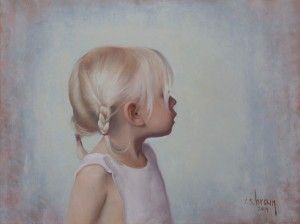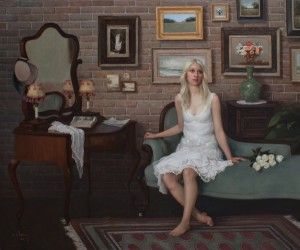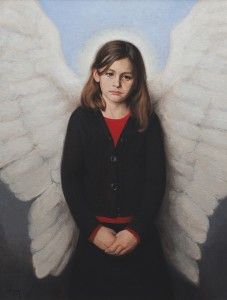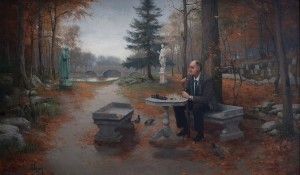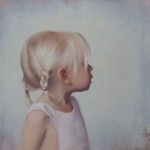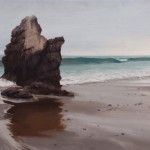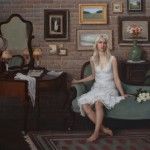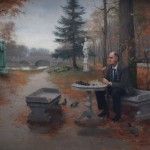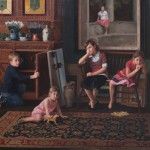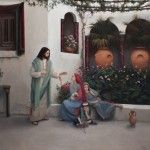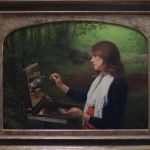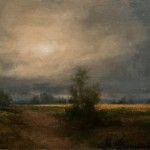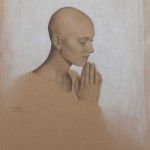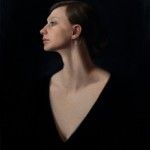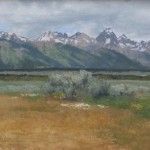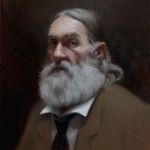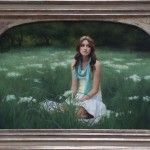Ryan S. Brown employs time-honored techniques to portray the people and places he loves
By Norman Kolpas
This story was featured in the December 2014 issue of Southwest Art magazine. Get the Southwest Art December 2014 print issue or digital download now–then subscribe to Southwest Art and never miss another story!
It was a quiet Sunday not long ago in Springville, UT, a small town nestled up against the foothills of the Wasatch Mountains, about an hour south of Salt Lake City. Ryan S. Brown and his family were just home from church when a painting suddenly demanded to be made.
“I usually take Sundays off,” says Brown. But on this particular day, the sight of his youngest child, Aiden, arrested his attention. “Here comes this towheaded little girl,” he recalls. “It was the first time her hair was long enough to put in braids, and it was such a beautiful color against her pale skin.” He just had to paint her.
His daughter still in her pale-pink Sunday finest, Brown drove with her to his studio in town, part of a 5,000-square-foot school he created called The Center for Academic Study & Naturalist Painting, or CAS for short. As he does for many of his portraits and other works from life, he began by taking photographs—in this case, about 300 images. “Fortunately, Aiden really liked posing,” he says with the warm chuckle of any parent who has tried to keep a 2-year-old sitting still.
Back home, having selected a pose he liked and returned Aiden to her mother’s care, Brown began painting in a corner he has set up “where, if I have to, I can work while watching football on Sundays.” He selected a 9-by-12-inch copper plate that he’d been wanting to try as a painting surface. Old masters, including Rembrandt, sometimes employed the rigid, sublimely smooth surface for small oils featuring exquisite detail in ultra-fine brush strokes. After about 15 hours of work—spread over a few sessions to give the delicate layers of paint time to dry—Brown had completed a portrait he entitled simply AIDEN, a breathtakingly realistic image infused with both a child’s sweet innocence and a parent’s love.
In microcosm, that work captures the particular appeal of Brown’s paintings. He chooses to paint whatever speaks to his heart at any given moment in his life, be it his children, a still life of flowers or fruit, a real or imagined landscape, or a Biblical scene expressing his quiet faith. “Career-wise,” he laughs, “it would be much easier for me if I picked one thing and had a recognizable brand. But I love painting everything.”
Whatever the subject, Brown goes about depicting it in a style he’ll refer to as “naturalist.” He applies that term only reluctantly because, he says, “I try to avoid labels. I want to let the subject dictate how it needs to be painted.”
And in that spirit of respecting, even revering, whatever subject he paints, Brown brings to bear on each work a set of skills that trace their lineage back at least half a millennium. If the painting calls for a delicate, lifelike touch, he’ll paint it on copper. If the subject dictates the texture of linen to evoke the dreamy mood of a moonlit landscape, he’ll begin by attaching the fabric to a rigid birch board using rabbit-skin glue—just as Renaissance artists did—and then priming the canvas with a coating of white lead paint to provide the ideal stable, neutral ground for his colors.
“I’m trying to hold myself to a higher standard,” Brown says, summing up not only his technical approach but also his steadfast dedication to self-improvement. “The only way to achieve what I want to achieve is to be completely focused on it.”
Brown will be the first one to admit that he didn’t always possess such focus and drive. Yes, he showed some artistic ability at an early age insofar as he often drew, and drew well. But, at first, no clear path appeared that might one day lead him to become the painter he is today.
He says his fifth-grade teacher, Mrs. Grandinetti, at Hunter Elementary in the Salt Lake City suburb of West Valley, must have seen something in him. She suggested that his mom buy him a copy of the best-selling guide to teaching oneself basic artistic draftsmanship, Drawing on the Right Side of the Brain by Betty Edwards. She also signed up young Ryan for after-school art classes. “In the after-school thing,” he says, “I made a little watercolor of a mountain scene with some trees. It won best of show in a regional contest, and I got a $20 gift certificate to an art store.”
Despite that early success, and his continued enrollment in whatever art classes his junior high offered, he seldom felt motivated by art. “I took wood shop and really liked that,” he says, “but the other art classes were kind of a joke.” High school was little better. “I tried to get a little more serious, but there was really no instruction or direction to it. I kind of dabbled.”
Still, he entered the arts department at Brigham Young University, opting for studies in illustration because, he says, “the studio art part was postmodern, and the splatter-paint stuff was never valid to me. The illustration side still had ties to tradition.”
Through his studies, he gained an appreciation for the great American illustrators of a century ago and longer, including Edwin Austin Abbey, J.C. Leyendecker, and Dean Cornwell. But he never felt adequately schooled in the techniques he needed in order to draw and paint like those icons. “I haven’t seen a university art department that’s effective at teaching that,” he says. “The best it can do is make you aware of things you’ll never learn there, an overview of stuff you’d never have time to develop a knowledge of.”
That describes Brown’s frustrated state of mind when, toward the end of his studies at BYU, he heard about the Florence Academy of Art. Founded in 1991 in the Tuscan capital by American realist Daniel Graves, the academy dedicates itself to disciplined, atelier-style art instruction modeled after the learning methods practiced through the centuries by the masters of western European art. In January 2003, half a year after he graduated with a BFA in illustration, Brown enrolled at the Florence Academy, moving there with his young family.
“In the first three weeks there,” he marvels, “I’d learned more about drawing than in four years at the university. It was just a very clear, organized, direct approach.” Brown thrived there. But after six months, with money running low and his wife, Courtney, expecting their second child, he returned to Utah. He began teaching painting classes himself at BYU and Utah Valley University, and then privately in his own studio following the classical approach he’d learned in Florence. Gradually, his own paintings began to sell as well. Eventually, in January 2007, Brown was able once again to pack up his family, now with three children, and return to Florence, where he graduated from the academy in the summer of 2008.
Although he’s been back home in Utah now for more than six years, Brown still yearns to return to Europe. “Living there was much more family-friendly,” he observes, “with all the parks and the little places to eat and shopping for food every day.” It also fed his aesthetic sensibilities. “The pace and the history and the architecture and the proximity to museums were constant inspirations. There was so much to look at that my head was always on a swivel.” So he plans, when finances allow, to pack up everyone and return, most likely to the environs of Paris, where he hopes to open another school of his own.
Meanwhile, Brown shares the knowledge he’s acquired through his CAS in Springville, where 12 students currently study for about 35 hours a week, including morning and afternoon painting sessions and daily critiques. This enables him to pass along his knowledge of and passion for realist art. “The ability to depict something with tangible reality makes the most powerful art that’s ever been, art that connects to average viewers in a deeper way because it’s closer to their visual experience,” he proclaims.
With that potential for forging human connections in mind, Brown is constantly striving to make the impact of his own works ever more powerful. “I always feel I’m capable of more,” he states with simple conviction. Though he says he usually has a dozen or so different paintings in the works at any given time, with two or three of those receiving his primary attention, his goal right now is to “slow down, taking more time to think things through. I want to make every single painting I’m working on as excellent as it can possibly be.”
representation
S.R. Brennan Galleries, Palm Desert, CA, and Santa Fe, NM; Principle Gallery, Alexandria, VA, and Charleston, SC; Haynes Galleries, Nashville, TN, and Thomaston, ME; Tree’s Place, Orleans, MA; Astoria Fine Art, Jackson, WY.
Featured in the December 2014 issue of Southwest Art magazine–click below to purchase:
Southwest Art December 2014 print issue or digital download Or subscribe to Southwest Art and never miss a story!
- Ryan S. Brown, Aiden, oil, 9 x 12.
- Ryan S. Brown, El Matador, Malibu, oil, 16 x 30.
- Ryan S. Brown, Le Premier Chagrin, oil, 40 x 48.
- Ryan S. Brown, The Master and His Rival, oil, 30 x 50.
- Ryan S. Brown, Our Mortal Probation, oil, 40 x 30.
- Ryan S. Brown, Waiting for Dad at the Studio (A Portrait of my Family), oil, 54 x 70.
- Ryan S. Brown, Christ Consoling the Widow, oil, 60 x 60.
- Ryan S. Brown, Deep Woods Falls, oil, 40 x 60.
- Ryan S. Brown, En Plein Air, oil, 24 x 32.
- Ryan S. Brown, Moonlight Through the Clouds, oil, 14 x 20.
- Ryan S. Brown, Perseverance, pencil/gouache, 22 x 15.
- Ryan S. Brown, Sonja, oil, 24 x 20.
- Ryan S. Brown, Teton Summer, oil, 16 x 30.
- Ryan S. Brown, The Traveling Philosopher, oil, 18 x 14.
- Ryan S. Brown, Wildflowers, oil, 30 x 44.
MORE RESOURCES FOR ART COLLECTORS & ENTHUSIASTS
• Subscribe to Southwest Art magazine
• Learn how to paint & how to draw with downloads, books, videos & more from North Light Shop
• Sign up for your Southwest Art email newsletter & download a FREE ebook






